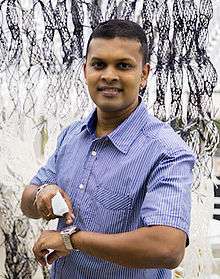Suranga Nanayakkara
| Suranga Nanayakkara | |
|---|---|
 Suranga Nanayakkara working with EyeRing | |
| Born |
10 October 1981 Piliyandala, Colombo, Sri Lanka |
| Nationality | Sri Lankan |
| Institutions | Singapore University of Technology and Design |
| Alma mater |
National University of Singapore(B.Eng.) National University of Singapore(PhD) MIT Media Lab(Postdoc) |
| Doctoral advisor | Lonce Wyse, Elizabeth Taylor and SH Ong |
| Other academic advisors | Pattie Maes |
| Known for | Inventor of EyeRing, SPARSH, StickEar and HapticChair |
|
Website suranga.info | |
Suranga Nanayakkara (born 1981) is a Sri Lankan computer scientist and Inventor.[1] As of 2014, he was the head of Augemented Human Lab and Assistant Professor at Singapore University of Technology and Design. He is best known for his work on EyeRing[2][3][4][5] and Haptic Chair.[6] His research interests include Wearable Computing, Assistive Technology, Ubiquitous computing, AI, Collective intelligence and Robotics. MIT Technology Review honored Nanayakkara as one of the Innovators Under 35 for Asia Pacific Region 2014.[7][8]
Education and research
Suranga is from Piliyandala, which is situated in Colombo District in Sri Lanka. After a very difficult start,[9][10] he completed bachelor's degree in electrical and computer engineering from the National University of Singapore in Singapore. He holds a PhD in Engineering from National University of Singapore. Suranga spent half a year at University of Birmingham and half a year at University of Southern California under student exchange program. Later he was a postdoctoral researcher with Pattie Maes’s Fluid Interfaces Group at MIT Media Lab.[11][12]
Career
He joined Singapore University of Technology and Design as an assistant professor in 2011, and as of 2014 served as the head of the Augmented Human Lab.[13]
Inventions
Suranga is best known for his work EyeRing - A finger-worn interface for seamless interactions[2][3][4] [5] Haptic Chair - Audio visual system to provide a more satisfying musical experience to deaf people[6] and StickEars – a sound-based sticky note like device to make everyday objects more accessible.[14][15][16] Among some of his other work, Suranga has invented SPARSH – a way to copy-paste data between digital devices; FingerDraw - way to extract colours and textures from nature and bring them into digital drawings.
Awards and achievements
- Ten Outstanding Young Persons (TOYP), Sri Lanka award 2015, by JCI Sri Lanka
- Young Innovator under 35 (MIT TR35) 2014 award, Asia Pacific region.[7]
- Finalist, Singapore Challenge, Global Young Scientist Summit (GYSS’14).[17]
- Interactive installation, iSwarm, selected for i Light Singapore 2014 Light show[18]
References
- ↑ "Creating the next generation of innovators". Sundaytimes. Retrieved 2014-09-07.
- 1 2 "Camera-Equipped "EyeRing" Helps Visually Impaired Identify Objects=". Ecouterre. Retrieved 2014-06-19.
- 1 2 "EyeRing helps visually impaired point, press, and hear information". PHYS.ORG. Retrieved 2014-06-19.
- 1 2 "With the Camera-Equipped "EyeRing" You Can Point at an Object and Take a Photo". Inhabitat. Retrieved 2014-06-19.
- 1 2 "Camera-toting EyeRing could help blind people to "see" objects". Gizmag. Retrieved 2014-06-19.
- 1 2 "New technology to help the deaf enjoy music". official website. National University of Singapore College of Engineering. Retrieved 2014-06-14.
- 1 2 "MIT TR35". MIT TR35. Retrieved 2014-06-19.
- ↑ "EmTech Singapore A". EMTech. Retrieved 2014-06-19.
- ↑ "Against the Odds". Tech Wire. Retrieved 2014-06-19.
- ↑ "Econnect" (PDF). National University of Singapore. Retrieved 2014-06-25.
- ↑ "People, Fluid Interfaces Group". Fluid Interfaces. Retrieved 2014-06-19.
- ↑ "about Suranga Nanayakkara". suranga.info. Retrieved 2014-06-14.
- ↑ "Augmented Human Lab". ahlab.org. Retrieved 2014-06-14.
- ↑ "Wireless device lends a listening ear" (PDF). Straits Times. Retrieved 2014-06-19.
- ↑ "Wireless device lends a listening ear". AsiaOne. Retrieved 2014-06-19.
- ↑ "Helping our hearing-impaired communities". Helping hearing-impaired communities. Retrieved 2014-06-19.
- ↑ "GYSS'14". GYSS. Retrieved 2014-06-14.
- ↑ "iSwarm - i Light 2014". i Light 2014. Retrieved 2014-06-19.
External links
- Official website
- Documentary about Suranga in a Global Vision TV, Japan
- Suranga Nanayakkara's work on Yahoo News
- Creating the next generation of innovators
- Suranga Nanayakkara at TR35 Singapore